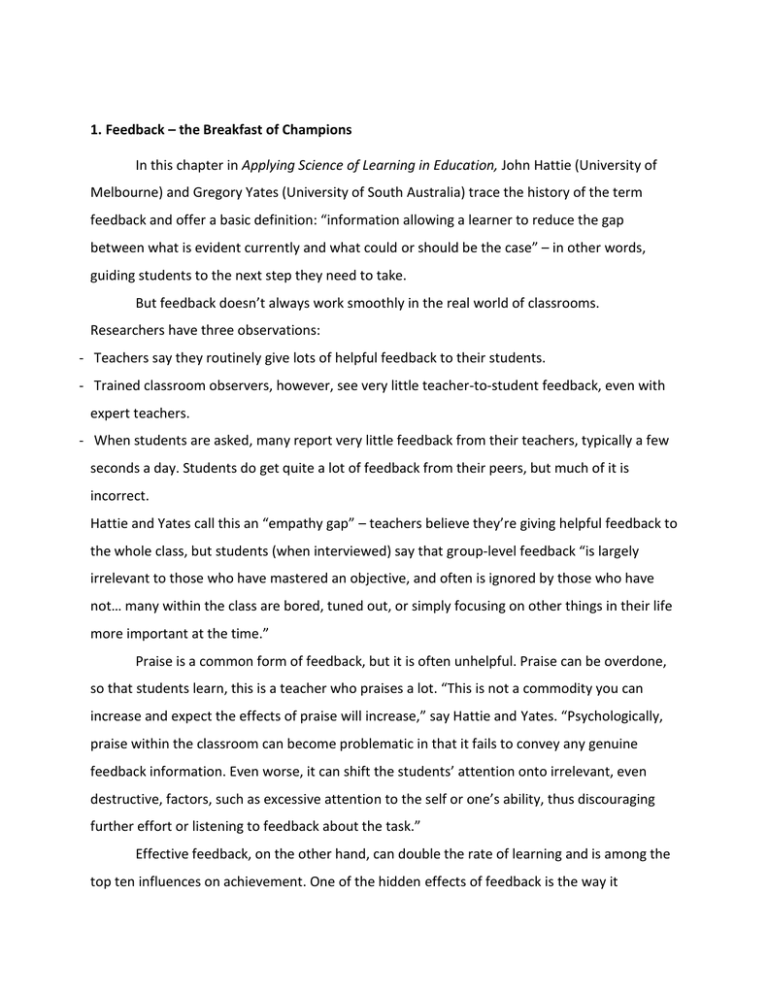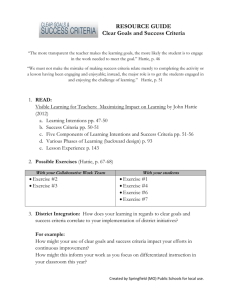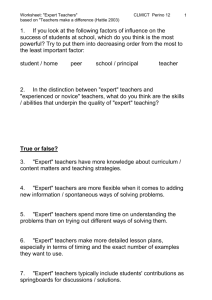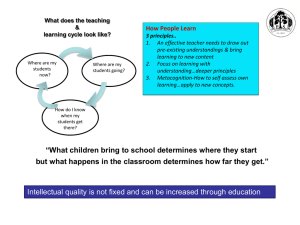Document 18138304
advertisement

1. Feedback – the Breakfast of Champions In this chapter in Applying Science of Learning in Education, John Hattie (University of Melbourne) and Gregory Yates (University of South Australia) trace the history of the term feedback and offer a basic definition: “information allowing a learner to reduce the gap between what is evident currently and what could or should be the case” – in other words, guiding students to the next step they need to take. But feedback doesn’t always work smoothly in the real world of classrooms. Researchers have three observations: - Teachers say they routinely give lots of helpful feedback to their students. - Trained classroom observers, however, see very little teacher-to-student feedback, even with expert teachers. - When students are asked, many report very little feedback from their teachers, typically a few seconds a day. Students do get quite a lot of feedback from their peers, but much of it is incorrect. Hattie and Yates call this an “empathy gap” – teachers believe they’re giving helpful feedback to the whole class, but students (when interviewed) say that group-level feedback “is largely irrelevant to those who have mastered an objective, and often is ignored by those who have not… many within the class are bored, tuned out, or simply focusing on other things in their life more important at the time.” Praise is a common form of feedback, but it is often unhelpful. Praise can be overdone, so that students learn, this is a teacher who praises a lot. “This is not a commodity you can increase and expect the effects of praise will increase,” say Hattie and Yates. “Psychologically, praise within the classroom can become problematic in that it fails to convey any genuine feedback information. Even worse, it can shift the students’ attention onto irrelevant, even destructive, factors, such as excessive attention to the self or one’s ability, thus discouraging further effort or listening to feedback about the task.” Effective feedback, on the other hand, can double the rate of learning and is among the top ten influences on achievement. One of the hidden effects of feedback is the way it influences how much effort students are willing to commit. One study found that college students devote considerably more time and effort to tasks where specific and timely feedback is available, perhaps because that shows the importance the teacher places on the learning activity. Hattie and Yates suggest that computer video games and GPS devices are excellent feedback-givers. Video games know each player’s past history, pose challenges at the Goldilocks level – slightly beyond past accomplishment, not too hard, not too easy – and give feedback as the player persists for hours at a time. A GPS device guides a driver through unfamiliar territory, doesn’t growl at mistakes, and maintains a patient, unemotional disposition as the driver finds his or way. Both technologies are good at knowing three important facts, all of which transfer to classroom feedback: • Where is the student going? What’s the goal? “Feedback does not work in a vacuum,” say Hattie and Yates. “Instead, it registers discrepancy between the current state and a known objective… Each student’s fundamental problem is to understand his or her world, and to feel able to control, or at least make more predictable, key elements that impact directly on adjustment within that world. One of the basal problems facing each student sitting in a classroom is assessing what to learn, how much to learn, and how much – and where – to expend effort.” A challenging goal – knowing what success looks like – is essential to getting students to apply effort, but knowing there will be feedback along the way is equally important. “People work hard on difficult goals once they can perceive the availability of salient and supportive feedback,” say the authors. “On the other hand, such feedback is unimportant if a goal is facile.” Teachers also need to lay out a series of stepping-stone goals on the way to the eventual target. Providing “worked examples of the goal” is also helpful. And of course it’s essential that teachers convey the idea that the goal is attainable and students will get there. • How is the student doing right now? What progress is being made? “For goals to be effective, students need information about current achievements,” say Hattie and Yates. “Feedback needs to take the form of realistic assessments as to how far along the journey the student has come, and can serve to reduce cognitive load by showing the student where in this sequence they need to exert their thinking and effort.” Feedback on progress is much more helpful than grades or comparisons to how other students are doing. Lots of errors are made at this stage, and teachers have to inculcate a positive view – errors are feedback on the road to success. “Feedback must engage a learner at, or just above, the current level of functioning,” say the authors. • What is the next step? This builds on the first two. “Students are disinterested in past errors and post-mortems,” say Hattie and Yates, “but clamor for guidance as to what to do in the future, as defined in terms of the next few minutes. The teacher’s role is how to enable resources, help, instruction, and scaffolds to be in place to assist the student to know where to next? A clear direction has to be identified.” The GPS device is a good model – it “can only look forward,” say the authors. “It remains unconcerned about any past streets, suburbs, or erstwhile errors passed through on route… We may get to a location through using different roads and we may take longer or shorter to get there. But such differences are superficial since options are constrained severely by reality. At some point, all routes to one goal will converge, even though the starting points vary.” Feedback looks different at the novice, intermediate, and advanced level. Beginners need immediate feedback on content knowledge and vocabulary – lots of assurance and correctives, as well as reassurance that they’re heading in the right direction. Intermediate learners need feedback like, “Strong use of adjectives in just the right spots” and “A wellconstructed argument, but have you thought of what this implies for the future?” Advanced students need help developing themselves as self-regulated learners. The teacher’s task is to gradually build students’ ability to self-correct, and that means becoming more critical (without negative affect) and sometimes withholding feedback as students become more proficient, spurring the retrieval process and building independent learning skills. “Once students are aware that they have some distance to travel, then ‘errors’ are no longer perceived as negative,” say Hattie and Yates. “Errors are tentative trials rather than the endgame.” “For many students,” the authors conclude, “school learning is hard, mentally demanding, and potentially energy-sapping. At the individual level, the problem is to perceive a knowledge chasm as a knowledge gap to be bridged. Such a view is aided by two other necessary perceptions: (a) that one’s achievement is not limited by inherently fixed attributes such as intelligence, and (b) outcome is correlated with effort… This is the essential classroom context within which teachers’ use of the feedback principle will determine how their students will elect to deploy their limited energies.” “Using Feedback to Promote Learning” by John Hattie and Gregory Yates in Applying Science of Learning in Education: Infusing Psychological Science into the Curriculum, American Psychological Association, 2014 (p. 45-58), http://teachpsych.org/resources/documents/ebooks/asle2014.pdf



